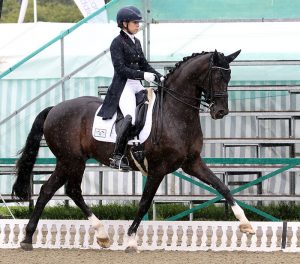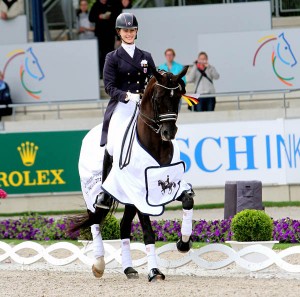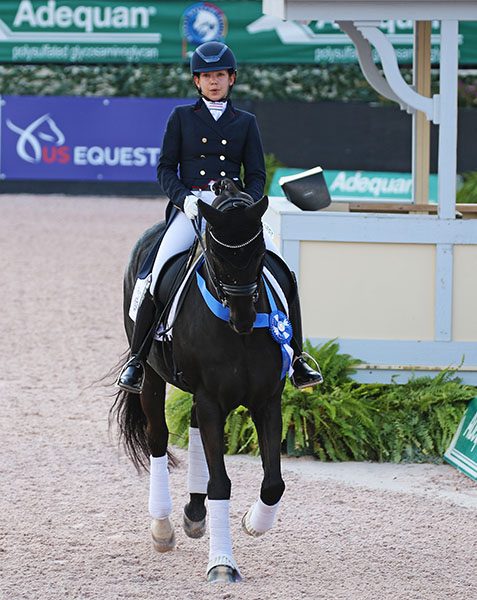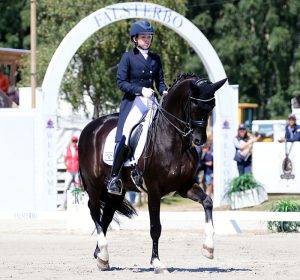Sagacious HF Wins Reprieve After Testing Positive for Deadly Infection on Return from European Success
7 years ago StraightArrow Comments Off on Sagacious HF Wins Reprieve After Testing Positive for Deadly Infection on Return from European Success

By KENNETH J. BRADDICK
WELLINGTON, Florida, Aug. 11, 2017–Sagacious HF, the Dutch gelding that has competed for the United States for the past decade including winning Pan American Games gold, on Friday won a stay of execution after the horse was initially declared positive for the deadly infectious virus glanders on its return from competing in Europe.
Sagacious will remain quarantined at Miami International Airport until U.S. Department of Agriculture tests clear the horse for release and a return to Wellington where he’s based with rider Chase Hickok. The next series of tests are scheduled for Aug. 23. If Sagacious is not cleared, the USDA could extend the quarantine until he is cleared or the horse will have to be returned to Amsterdam as the point of origin or euthanized.
The horse was given a reprieve after being cleared in a test that is different and considered more accurate than those conducted by the USDA and that produced two positive results for glander, an infection that can be passed to humans as well as other animals.
Sagacious arrived at Miami from Amsterdam a week ago. Chase drove a trailer to Miami on Wednesday to pick up Sagacious and another horse she was importing.
However, she was informed that Sagacious would not be released because of two positive tests for glanders.
She was told by the USDA that Sagacious would have to be shipped back to the point of origin by Friday or would be put down.
Al Guden, the owner for virtually the entire lifetime of Sagacious (Welt Hit II x Cocktail) and performing years younger than his age of 18, pledged to do everything possible to save the horse.
In a week that has been as emotional as any Al has experienced in the life of Sagacious, he enlisted Lexington, Kentucky lawyer Chapman Hopkins who had been involved in a similar case of an Irish racehorse last Christmas to help get U.S. government veterinarians to conduct a test considered more accurate.
The new test was negative for glanders.
The USDA put a hold on its protocol that the two positive results from the earlier tests would have required Sagacious to be returned to Amsterdam, the point of origin if the Netherlands allowed, or euthanized. Europe and the United States have been mostly glanders-free for seven decades, though an outbreak in Germany two years ago led to Australia imposing a six-month quarantine on horses being shipped Down Under.
Chapman Hopkins, who is active in the horse industry both with Thoroughbreds and sport horses in dressage, hunter/jumpers and eventing, brought with him the experience from the Southern California case. And he read up on the history of Sagacious.
Al Guden of Hyperion Farm had partnered in buying the horse then named Sjors B at three months old and initially kept in the Netherlands. He ended up buying out the partners and brought the horse, renamed Sagacious, to America as a three-year-old, at first treating it as a “hobby” and not the “once in a lifetime” experience that resulted.

Lauren Sammis of South Orange, NewJersey began competing the horse in 2006 and a year later was on the U.S. team for the Pan American Games in Rio de Janeiro, an event that was fraught with emotion as Al’s wife had terminal breast cancer and was unable to go to Rio. Lauren dedicated the performances on Sagacious for team gold and individual silver to Judy Guden.
Lauren rode Sagacious in the national Grand Prix championships in 2009, 2010, 2011 and 2012.
Caroline Roffman, named the International Equestrian Federation (FEI) Rising Star in 2010, took over the ride and competed at Under-25 in the world’s premier horse show, at Aachen, Germany in 2013.
She and Sagacious, the first American combination to compete in Aachen’s Under-25 division, placed second.

After the European tour, Caroline dropped plans to qualify for the Brentina Cup Under-25 American championships figuring the horse had done enough at the time.
However, Chase Hickok was looking for an experienced Grand Prix mount that she could compete in the Under-25 division and leased the horse at the end of 2014. The horse and rider became a partnership, racking up 10 straight wins in Under-25 CDIs at the Global Dressage Festival in Wellington in 2015 then won the national Under-25 Brentina Cup title. The pair went to Europe for the summer. They moved up to Big Tour in 2016.

Chase, now 27, and Sagacious rode on the American teams at the Nations Cups in Falsterbo, Sweden and Hickstead, England last month, becoming the highest placed Americans at both events and moving to No. 62 on the world rankings.
Glanders is caused by infection, usually from consuming contaminated feed or water. Signs of glanders include formation of lesions in the lungs and ulceration of mucous membranes in the upper respiratory tract. The acute form results in coughing, fever and the release of an infectious nasal discharge, followed by septicaemia and death within days. Endemic in Africa, Asia, the Middle East, and Central and South America, it has been eradicated from North America, Australia, and most of Europe through surveillance, destruction of affected animals and import restrictions.
The USDA uses a complement fixation test (CFT) that is prescribed for international trade but is regarded by many veterinarians, especially those dealing with high performance horses for international dressage, jumping and eventing competition, as not accurate enough.
The CFT test is reported to be under review by the USDA with plans to replace it with a so-called “Western blot’ procedure that was applied with Sagacious.
Before the situation with Sagacious, an Irish race horse was imported through the Los Angeles quarantine center for a Southern California syndicate, Little Red Feather, early last December. The CFT test produced two positive results for glanders and the USDA gave seven days notice to “put the horse down” or “return to origin.”
Ireland did not want back a horse found positive for glanders.
The syndicate had come to believe the CFT tests were not accurate enough so got lawyers, politicians and others to get USDA to reconsider its testing procedures.
The bottom line was that after enough time in quarantine, the horse tested negative for all infectious diseases and was allowed entry into the U.S. to spend a month on a farm away from the racetrack.
The horse raced at Del Mar on Jan. 21. It was not the first to pass the post but what the Little Red Feather syndicate regards as a “win.”


